语言学名词解释
- 格式:doc
- 大小:37.00 KB
- 文档页数:4
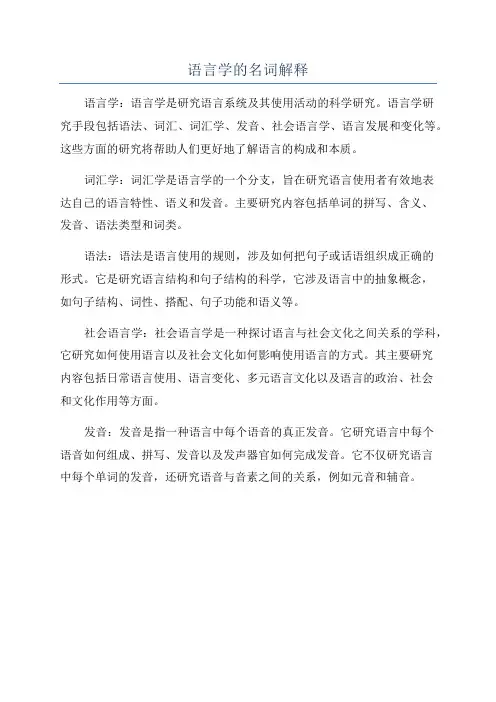
语言学的名词解释
语言学:语言学是研究语言系统及其使用活动的科学研究。
语言学研
究手段包括语法、词汇、词汇学、发音、社会语言学、语言发展和变化等。
这些方面的研究将帮助人们更好地了解语言的构成和本质。
词汇学:词汇学是语言学的一个分支,旨在研究语言使用者有效地表
达自己的语言特性、语义和发音。
主要研究内容包括单词的拼写、含义、
发音、语法类型和词类。
语法:语法是语言使用的规则,涉及如何把句子或话语组织成正确的
形式。
它是研究语言结构和句子结构的科学,它涉及语言中的抽象概念,
如句子结构、词性、搭配、句子功能和语义等。
社会语言学:社会语言学是一种探讨语言与社会文化之间关系的学科,它研究如何使用语言以及社会文化如何影响使用语言的方式。
其主要研究
内容包括日常语言使用、语言变化、多元语言文化以及语言的政治、社会
和文化作用等方面。
发音:发音是指一种语言中每个语音的真正发音。
它研究语言中每个
语音如何组成、拼写、发音以及发声器官如何完成发音。
它不仅研究语言
中每个单词的发音,还研究语音与音素之间的关系,例如元音和辅音。
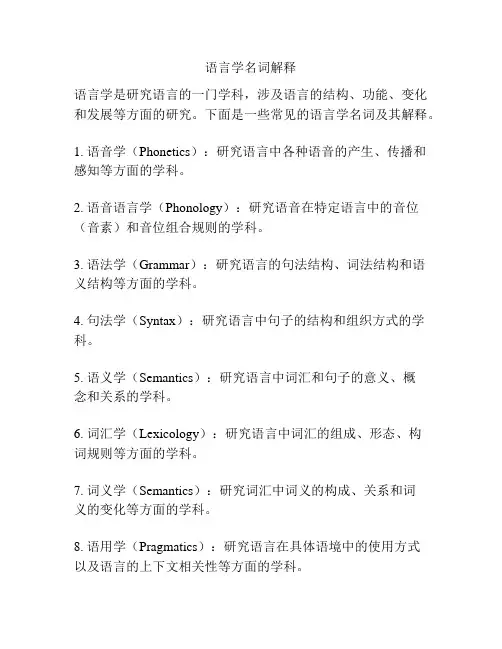
语言学名词解释语言学是研究语言的一门学科,涉及语言的结构、功能、变化和发展等方面的研究。
下面是一些常见的语言学名词及其解释。
1. 语音学(Phonetics):研究语言中各种语音的产生、传播和感知等方面的学科。
2. 语音语言学(Phonology):研究语音在特定语言中的音位(音素)和音位组合规则的学科。
3. 语法学(Grammar):研究语言的句法结构、词法结构和语义结构等方面的学科。
4. 句法学(Syntax):研究语言中句子的结构和组织方式的学科。
5. 语义学(Semantics):研究语言中词汇和句子的意义、概念和关系的学科。
6. 词汇学(Lexicology):研究语言中词汇的组成、形态、构词规则等方面的学科。
7. 词义学(Semantics):研究词汇中词义的构成、关系和词义的变化等方面的学科。
8. 语用学(Pragmatics):研究语言在具体语境中的使用方式以及语言的上下文相关性等方面的学科。
9. 文法学(Stylistics):研究语言使用中的文体、修辞手法、语言风格等方面的学科。
10. 母语(Mother tongue):一个人从小学会并用于日常交际的语言。
11. 第二语言(Second language):在学习者的母语之外学习的语言。
12. 语言接触(Language contact):不同语言之间在社会、文化接触中产生的相互影响和借用的现象。
13. 语言变异(Language variation):指同一个语言在不同社会、地理和使用者间发生的音、词、句法等方面的变化。
14. 语言变化(Language change):指语言在漫长的时间内逐渐变化和发展的过程。
15. 语言规范(Language standardization):制定和规范一个语言的正确用法、标准词汇和语法规则的过程。
16. 语言习得(Language acquisition):指儿童在自然环境中学习母语的过程。
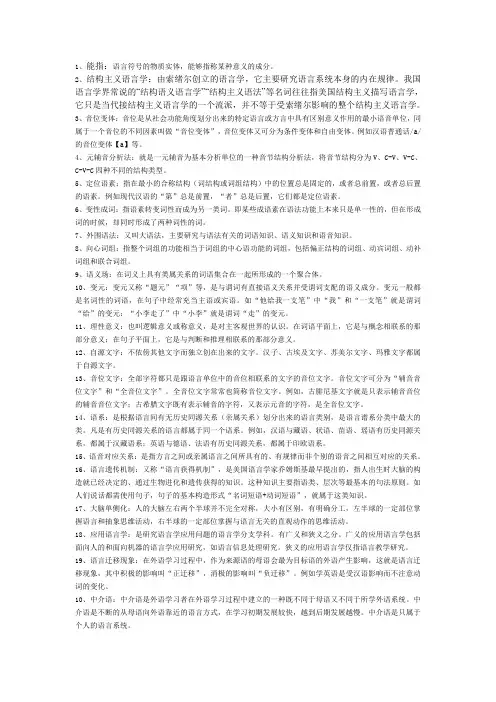
1、能指:语言符号的物质实体,能够指称某种意义的成分。
2、结构主义语言学:由索绪尔创立的语言学,它主要研究语言系统本身的内在规律。
我国语言学界常说的“结构语义语言学”“结构主义语法”等名词往往指美国结构主义描写语言学,它只是当代接结构主义语言学的一个流派,并不等于受索绪尔影响的整个结构主义语言学。
3、音位变体:音位是从社会功能角度划分出来的特定语言或方言中具有区别意义作用的最小语音单位,同属于一个音位的不同因素叫做“音位变体”,音位变体又可分为条件变体和自由变体。
例如汉语普通话/a/的音位变体【a】等。
4、元辅音分析法:就是一元辅音为基本分析单位的一种音节结构分析法,将音节结构分为V、C-V、V-C、C-V-C四种不同的结构类型。
5、定位语素:指在最小的合称结构(词结构或词组结构)中的位置总是固定的,或者总前置,或者总后置的语素。
例如现代汉语的“第”总是前置,“者”总是后置,它们都是定位语素。
6、变性成词:指语素转变词性而成为另一类词。
即某些成语素在语法功能上本来只是单一性的,但在形成词的时候,却同时形成了两种词性的词。
7、外围语法:又叫大语法,主要研究与语法有关的词语知识、语义知识和语音知识。
8、向心词组:指整个词组的功能相当于词组的中心语功能的词组,包括偏正结构的词组、动宾词组、动补词组和联合词组。
9、语义场:在词义上具有类属关系的词语集合在一起所形成的一个聚合体。
10、变元:变元又称“题元”“项”等,是与谓词有直接语义关系并受谓词支配的语义成分。
变元一般都是名词性的词语,在句子中经常充当主语或宾语。
如“他给我一支笔”中“我”和“一支笔”就是谓词“给”的变元;“小李走了”中“小李”就是谓词“走”的变元。
11、理性意义:也叫逻辑意义或称意义,是对主客观世界的认识。
在词语平面上,它是与概念相联系的那部分意义;在句子平面上,它是与判断和推理相联系的那部分意义。
12、自源文字:不依傍其他文字而独立创在出来的文字。
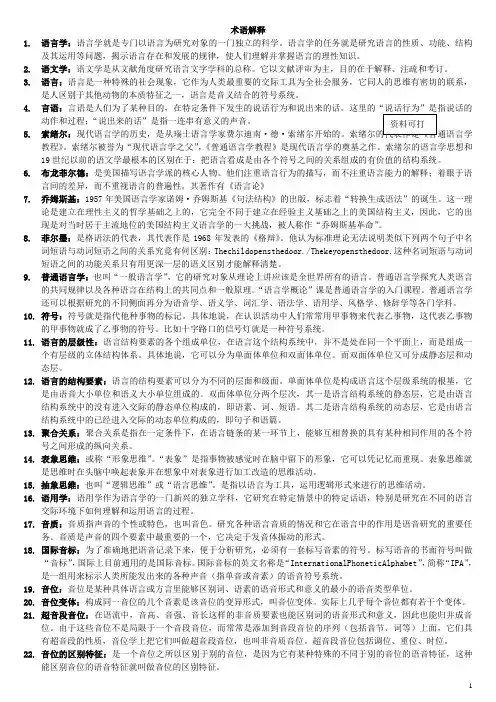
术语解释1.语言学:语言学就是专门以语言为研究对象的一门独立的科学。
语言学的任务就是研究语言的性质、功能、结构及其运用等问题,揭示语言存在和发展的规律,使人们理解并掌握语言的理性知识。
2.语文学:语文学是从文献角度研究语言文字学科的总称。
它以文献评审为主,目的在于解释、注疏和考订。
3.语言:语言是一种特殊的社会现象,它作为人类最重要的交际工具为全社会服务,它同人的思维有密切的联系,是人区别于其他动物的本质特征之一,语言是音义结合的符号系统。
4.言语:言语是人们为了某种目的,在特定条件下发生的说话行为和说出来的话。
这里的“说话行为”是指说话的5.索绪尔:教程》。
索绪尔被誉为“现代语言学之父”,《普通语言学教程》是现代语言学的奠基之作。
索绪尔的语言学思想和19世纪以前的语文学最根本的区别在于:把语言看成是由各个符号之间的关系组成的有价值的结构系统。
6.布龙菲尔德:是美国描写语言学派的核心人物。
他们注重语言行为的描写,而不注重语言能力的解释;着眼于语言间的差异,而不重视语言的普遍性。
其著作有《语言论》7.乔姆斯基:1957年美国语言学家诺姆·乔姆斯基《句法结构》的出版,标志着“转换生成语法”的诞生。
这一理论是建立在理性主义的哲学基础之上的,它完全不同于建立在经验主义基础之上的美国结构主义,因此,它的出现是对当时居于主流地位的美国结构主义语言学的一大挑战,被人称作“乔姆斯基革命”。
8.菲尔墨:是格语法的代表,其代表作是1968年发表的《格辩》。
他认为标准理论无法说明类似下列两个句子中名词短语与动词短语之间的关系究竟有何区别:Thechildopensthedoor./Thekeyopensthedoor.这种名词短语与动词短语之间的功能关系只有用更深一层的语义区别才能解释清楚。
9.普通语言学:也叫“一般语言学”,它的研究对象从理论上讲应该是全世界所有的语言。
普通语言学探究人类语言的共同规律以及各种语言在结构上的共同点和一般原理。
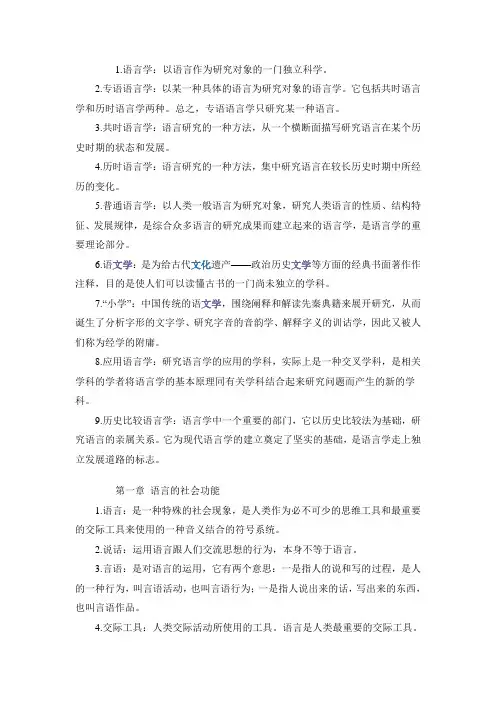
1.语言学:以语言作为研究对象的一门独立科学。
2.专语语言学:以某一种具体的语言为研究对象的语言学。
它包括共时语言学和历时语言学两种。
总之,专语语言学只研究某一种语言。
3.共时语言学:语言研究的一种方法,从一个横断面描写研究语言在某个历史时期的状态和发展。
4.历时语言学:语言研究的一种方法,集中研究语言在较长历史时期中所经历的变化。
5.普通语言学:以人类一般语言为研究对象,研究人类语言的性质、结构特征、发展规律,是综合众多语言的研究成果而建立起来的语言学,是语言学的重要理论部分。
6.语文学:是为给古代文化遗产——政治历史文学等方面的经典书面著作作注释,目的是使人们可以读懂古书的一门尚未独立的学科。
7.“小学”:中国传统的语文学,围绕阐释和解读先秦典籍来展开研究,从而诞生了分析字形的文字学、研究字音的音韵学、解释字义的训诂学,因此又被人们称为经学的附庸。
8.应用语言学:研究语言学的应用的学科,实际上是一种交叉学科,是相关学科的学者将语言学的基本原理同有关学科结合起来研究问题而产生的新的学科。
9.历史比较语言学:语言学中一个重要的部门,它以历史比较法为基础,研究语言的亲属关系。
它为现代语言学的建立奠定了坚实的基础,是语言学走上独立发展道路的标志。
第一章语言的社会功能1.语言:是一种特殊的社会现象,是人类作为必不可少的思维工具和最重要的交际工具来使用的一种音义结合的符号系统。
2.说话:运用语言跟人们交流思想的行为,本身不等于语言。
3.言语:是对语言的运用,它有两个意思:一是指人的说和写的过程,是人的一种行为,叫言语活动,也叫言语行为;一是指人说出来的话,写出来的东西,也叫言语作品。
4.交际工具:人类交际活动所使用的工具。
语言是人类最重要的交际工具。
此外,身势等伴随动作是非语言的交际工具;旗语之类是建立在语言、文字基础上的辅助性交际工具;文字是建立在语言基础之上的一种最重要的辅助交际工具;5.思维:是认识现实世界时的一种动脑筋的过程,也指动脑筋时进行比较、分析、综合以认识现实的能力。
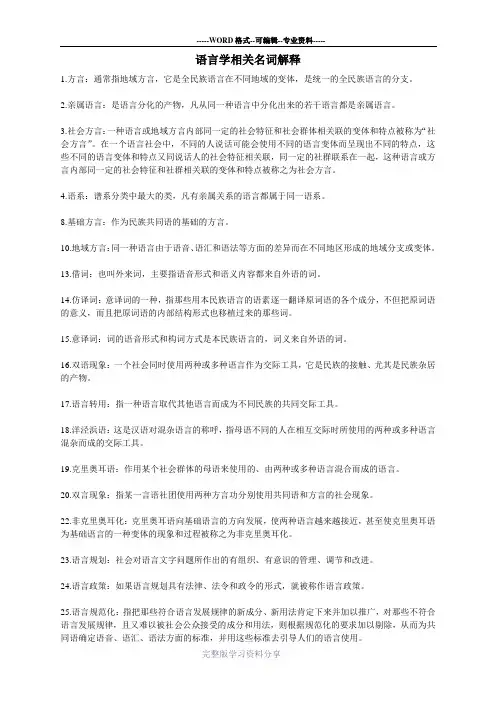
语言学相关名词解释1.方言:通常指地域方言,它是全民族语言在不同地域的变体,是统一的全民族语言的分支。
2.亲属语言:是语言分化的产物,凡从同一种语言中分化出来的若干语言都是亲属语言。
3.社会方言:一种语言或地域方言内部同一定的社会特征和社会群体相关联的变体和特点被称为“社会方言”。
在一个语言社会中,不同的人说话可能会使用不同的语言变体而呈现出不同的特点,这些不同的语言变体和特点又同说话人的社会特征相关联,同一定的社群联系在一起,这种语言或方言内部同一定的社会特征和社群相关联的变体和特点被称之为社会方言。
4.语系:谱系分类中最大的类,凡有亲属关系的语言都属于同一语系。
8.基础方言:作为民族共同语的基础的方言。
10.地域方言:同一种语言由于语音、语汇和语法等方面的差异而在不同地区形成的地域分支或变体。
13.借词:也叫外来词,主要指语音形式和语义内容都来自外语的词。
14.仿译词:意译词的一种,指那些用本民族语言的语素逐一翻译原词语的各个成分,不但把原词语的意义,而且把原词语的内部结构形式也移植过来的那些词。
15.意译词:词的语音形式和构词方式是本民族语言的,词义来自外语的词。
16.双语现象:一个社会同时使用两种或多种语言作为交际工具,它是民族的接触、尤其是民族杂居的产物。
17.语言转用:指一种语言取代其他语言而成为不同民族的共同交际工具。
18.洋泾浜语:这是汉语对混杂语言的称呼,指母语不同的人在相互交际时所使用的两种或多种语言混杂而成的交际工具。
19.克里奥耳语:作用某个社会群体的母语来使用的、由两种或多种语言混合而成的语言。
20.双言现象:指某一言语社团使用两种方言功分别使用共同语和方言的社会现象。
22.非克里奥耳化:克里奥耳语向基础语言的方向发展,使两种语言越来越接近,甚至使克里奥耳语为基础语言的一种变体的现象和过程被称之为非克里奥耳化。
23.语言规划:社会对语言文字问题所作出的有组织、有意识的管理、调节和改进。
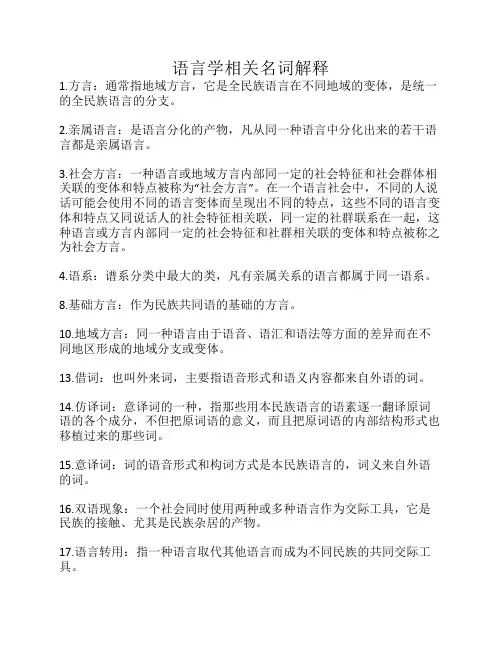
语言学相关名词解释1.方言:通常指地域方言,它是全民族语言在不同地域的变体,是统一的全民族语言的分支。
2.亲属语言:是语言分化的产物,凡从同一种语言中分化出来的若干语言都是亲属语言。
3.社会方言:一种语言或地域方言内部同一定的社会特征和社会群体相关联的变体和特点被称为“社会方言”。
在一个语言社会中,不同的人说话可能会使用不同的语言变体而呈现出不同的特点,这些不同的语言变体和特点又同说话人的社会特征相关联,同一定的社群联系在一起,这种语言或方言内部同一定的社会特征和社群相关联的变体和特点被称之为社会方言。
4.语系:谱系分类中最大的类,凡有亲属关系的语言都属于同一语系。
8.基础方言:作为民族共同语的基础的方言。
10.地域方言:同一种语言由于语音、语汇和语法等方面的差异而在不同地区形成的地域分支或变体。
13.借词:也叫外来词,主要指语音形式和语义内容都来自外语的词。
14.仿译词:意译词的一种,指那些用本民族语言的语素逐一翻译原词语的各个成分,不但把原词语的意义,而且把原词语的内部结构形式也移植过来的那些词。
15.意译词:词的语音形式和构词方式是本民族语言的,词义来自外语的词。
16.双语现象:一个社会同时使用两种或多种语言作为交际工具,它是民族的接触、尤其是民族杂居的产物。
17.语言转用:指一种语言取代其他语言而成为不同民族的共同交际工具。
18.洋泾浜语:这是汉语对混杂语言的称呼,指母语不同的人在相互交际时所使用的两种或多种语言混杂而成的交际工具。
19.克里奥耳语:作用某个社会群体的母语来使用的、由两种或多种语言混合而成的语言。
20.双言现象:指某一言语社团使用两种方言功分别使用共同语和方言的社会现象。
22.非克里奥耳化:克里奥耳语向基础语言的方向发展,使两种语言越来越接近,甚至使克里奥耳语为基础语言的一种变体的现象和过程被称之为非克里奥耳化。
23.语言规划:社会对语言文字问题所作出的有组织、有意识的管理、调节和改进。
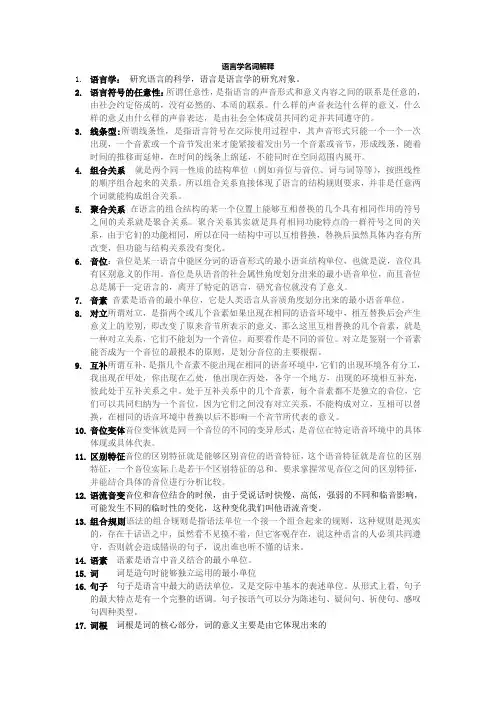
语言学名词解释1.语言学:研究语言的科学,语言是语言学的研究对象。
2.语言符号的任意性:所谓任意性,是指语言的声音形式和意义内容之间的联系是任意的,由社会约定俗成的,没有必然的、本质的联系。
什么样的声音表达什么样的意义,什么样的意义由什么样的声音表达,是由社会全体成员共同约定并共同遵守的。
3.线条型:所谓线条性,是指语言符号在交际使用过程中,其声音形式只能一个一个一次出现,一个音素或一个音节发出来才能紧接着发出另一个音素或音节,形成线条,随着时间的推移而延伸,在时间的线条上绵延,不能同时在空间范围内展开。
4.组合关系就是两个同一性质的结构单位(例如音位与音位、词与词等等),按照线性的顺序组合起来的关系。
所以组合关系直接体现了语言的结构规则要求,并非是任意两个词就能构成组合关系。
5.聚合关系在语言的组合结构的某一个位置上能够互相替换的几个具有相同作用的符号之间的关系就是聚合关系。
聚合关系其实就是具有相同功能特点的一群符号之间的关系,由于它们的功能相同,所以在同一结构中可以互相替换,替换后虽然具体内容有所改变,但功能与结构关系没有变化。
6.音位:音位是某一语言中能区分词的语音形式的最小语音结构单位,也就是说,音位具有区别意义的作用。
音位是从语音的社会属性角度划分出来的最小语音单位,而且音位总是属于一定语言的,离开了特定的语言,研究音位就没有了意义。
7.音素音素是语音的最小单位,它是人类语言从音质角度划分出来的最小语音单位。
8.对立所谓对立,是指两个或几个音素如果出现在相同的语音环境中,相互替换后会产生意义上的差别,即改变了原来音节所表示的意义,那么这里互相替换的几个音素,就是一种对立关系,它们不能划为一个音位,而要看作是不同的音位。
对立是鉴别一个音素能否成为一个音位的最根本的原则,是划分音位的主要根据。
9.互补所谓互补,是指几个音素不能出现在相同的语音环境中,它们的出现环境各有分工,我出现在甲处,你出现在乙处,他出现在丙处,各守一个地方,出现的环境相互补充,彼此处于互补关系之中。
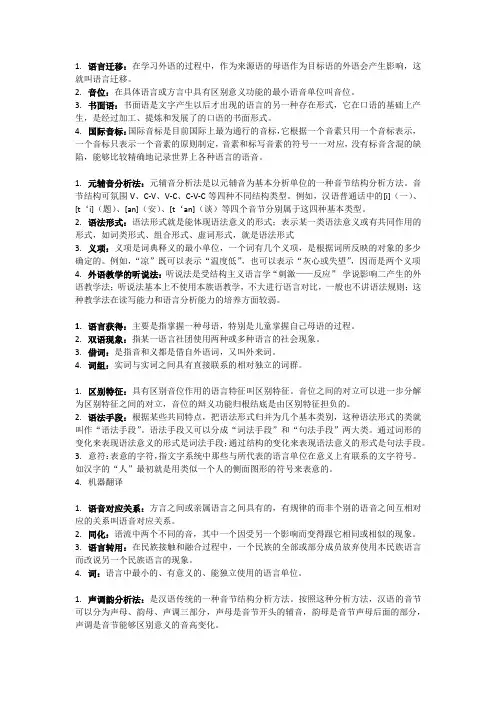
1.语言迁移:在学习外语的过程中,作为来源语的母语作为目标语的外语会产生影响,这就叫语言迁移。
2.音位:在具体语言或方言中具有区别意义功能的最小语音单位叫音位。
3.书面语:书面语是文字产生以后才出现的语言的另一种存在形式,它在口语的基础上产生,是经过加工、提炼和发展了的口语的书面形式。
4.国际音标:国际音标是目前国际上最为通行的音标,它根据一个音素只用一个音标表示,一个音标只表示一个音素的原则制定,音素和标写音素的符号一一对应,没有标音含混的缺陷,能够比较精确地记录世界上各种语言的语音。
1.元辅音分析法:元辅音分析法是以元辅音为基本分析单位的一种音节结构分析方法。
音节结构可氛围V、C-V、V-C、C-V-C等四种不同结构类型。
例如,汉语普通话中的[i](一)、[t‘i](题)、[an](安)、[t‘an](谈)等四个音节分别属于这四种基本类型。
2.语法形式:语法形式就是能体现语法意义的形式;表示某一类语法意义或有共同作用的形式,如词类形式、组合形式、虚词形式,就是语法形式3.义项:义项是词典释义的最小单位,一个词有几个义项,是根据词所反映的对象的多少确定的。
例如,“凉”既可以表示“温度低”,也可以表示“灰心或失望”,因而是两个义项4.外语教学的听说法:听说法是受结构主义语言学“刺激——反应”学说影响二产生的外语教学法;听说法基本上不使用本族语教学,不大进行语言对比,一般也不讲语法规则;这种教学法在读写能力和语言分析能力的培养方面较弱。
1.语言获得:主要是指掌握一种母语,特别是儿童掌握自己母语的过程。
2.双语现象:指某一语言社团使用两种或多种语言的社会现象。
3.借词:是指音和义都是借自外语词,又叫外来词。
4.词组:实词与实词之间具有直接联系的相对独立的词群。
1.区别特征:具有区别音位作用的语言特征叫区别特征。
音位之间的对立可以进一步分解为区别特征之间的对立,音位的辩义功能归根结底是由区别特征担负的。
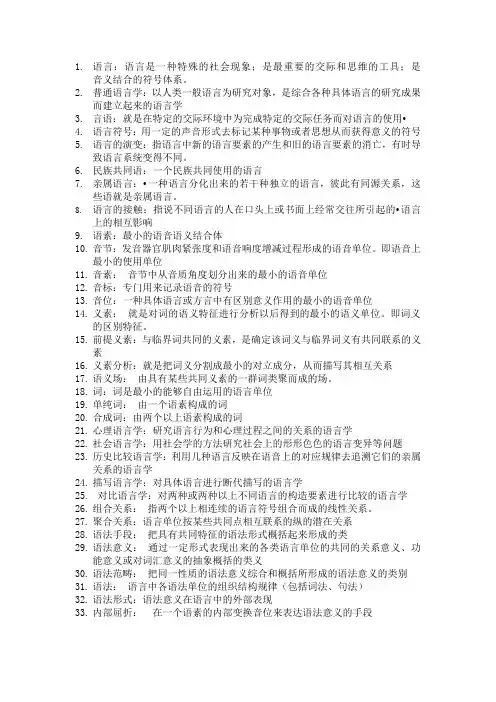
1.语言:语言是一种特殊的社会现象;是最重要的交际和思维的工具;是音义结合的符号体系。
2.普通语言学:以人类一般语言为研究对象,是综合各种具体语言的研究成果而建立起来的语言学3.言语:就是在特定的交际环境中为完成特定的交际任务而对语言的使用•4.语言符号:用一定的声音形式去标记某种事物或者思想从而获得意义的符号5.语言的演变:指语言中新的语言要素的产生和旧的语言要素的消亡,有时导致语言系统变得不同。
6.民族共同语:一个民族共同使用的语言7.亲属语言:•一种语言分化出来的若干种独立的语言,彼此有同源关系,这些语就是亲属语言。
8.语言的接触:指说不同语言的人在口头上或书面上经常交往所引起的•语言上的相互影响9.语素:最小的语音语义结合体10.音节:发音器官肌肉紧张度和语音响度增减过程形成的语音单位。
即语音上最小的使用单位11.音素:音节中从音质角度划分出来的最小的语音单位12.音标:专门用来记录语音的符号13.音位:一种具体语言或方言中有区别意义作用的最小的语音单位14.义素:就是对词的语义特征进行分析以后得到的最小的语义单位。
即词义的区别特征。
15.前提义素:与临界词共同的义素,是确定该词义与临界词义有共同联系的义素16.义素分析:就是把词义分割成最小的对立成分,从而描写其相互关系17.语义场:由具有某些共同义素的一群词类聚而成的场。
18.词:词是最小的能够自由运用的语言单位19.单纯词:由一个语素构成的词20.合成词:由两个以上语素构成的词21.心理语言学:研究语言行为和心理过程之间的关系的语言学22.社会语言学:用社会学的方法研究社会上的形形色色的语言变异等问题23.历史比较语言学:利用几种语言反映在语音上的对应规律去追溯它们的亲属关系的语言学24.描写语言学:对具体语言进行断代描写的语言学25.•对比语言学:对两种或两种以上不同语言的构造要素进行比较的语言学26.组合关系:指两个以上相连续的语言符号组合而成的线性关系。
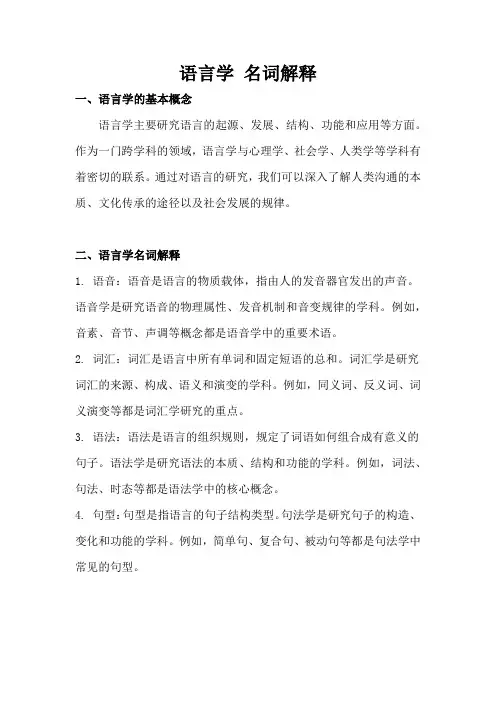
语言学名词解释
一、语言学的基本概念
语言学主要研究语言的起源、发展、结构、功能和应用等方面。
作为一门跨学科的领域,语言学与心理学、社会学、人类学等学科有着密切的联系。
通过对语言的研究,我们可以深入了解人类沟通的本质、文化传承的途径以及社会发展的规律。
二、语言学名词解释
1. 语音:语音是语言的物质载体,指由人的发音器官发出的声音。
语音学是研究语音的物理属性、发音机制和音变规律的学科。
例如,音素、音节、声调等概念都是语音学中的重要术语。
2. 词汇:词汇是语言中所有单词和固定短语的总和。
词汇学是研究词汇的来源、构成、语义和演变的学科。
例如,同义词、反义词、词义演变等都是词汇学研究的重点。
3. 语法:语法是语言的组织规则,规定了词语如何组合成有意义的句子。
语法学是研究语法的本质、结构和功能的学科。
例如,词法、句法、时态等都是语法学中的核心概念。
4. 句型:句型是指语言的句子结构类型。
句法学是研究句子的构造、变化和功能的学科。
例如,简单句、复合句、被动句等都是句法学中常见的句型。
(一)名词解释1.语言学:语言学是以人类语言作为研究对象的学科,研究人类语言的性质、结构、发展及其在社会生活中的运用以及语言研究成果的应用问题,等等。
分理论语言学和应用语言学两个领域。
2.“小学”:在中国古代,小学先从教授字的形(六书)、音、义开始,就把研究文字、训诂、音韵方面的学问统称为小学。
小学一直是经学的一部分,包括音韵学、训诂学、文字学三个分支学科。
3.非语言交际工具或副语言交际工具:人们在运用语言进行交际的时候,不但动嘴,而且脸部的表情、手的动作、乃至整个躯体的姿态等非语言的东西也都参加进来。
我们这些非语言的交际工具称为副语言交际工具。
副语言交际工具的使用范围非常有限,只能起辅助性的交际作用,以补充语言交际的某些不足。
4.辅助性交际工具:指的文字、旗语、电报代码等在语言的基础上产生的交际工具。
这些交际工具若离开语言就不能独立存在。
其特点是:都有特殊的服务领域,使用的范围相当狭窄。
5.符号:符号,就是指代某种事物的标记,记号,它是由一个社会的全体成员共同约定用来表示某种意义的标记和记号。
6.符号的任意性:任意性是语言符号的本质特征之一。
其含义是:语言符号的音义联系并非是本质的,必然的,而是由社会成员共同约定的,一种意义为什么要用这个声音形式,而不用那种声音形式,这中间没有什么道理可言,完全是偶然的、任意的。
语言符号和客观事物之间也没有必然联系。
7.语言符号:特定语言系统中作为音义结合体的语言单位称为语言符号。
与一般符号相比,语言符号的主要特点是:音义结合的任意性、能指的线性特征、所指组合的层次性等等。
8.语言的层级体系:语言的层级体系:语言的底层是一套音位,一种语言的音位的数目虽然只有几十个,却能构成数目众多的组合。
这些组合为语言符号准备了形式的部分。
语言的上层是音义结合的符号和符号的序列,这一层又分为若干级。
第一级是语素,意义在这里被装进形式的口袋,成了音义结合的最小的符号。
第二级是由语素构成的词,第三级是由词构成的句子。
名词解释:1、语文学语文学是以语言为研究对象的科学,它以人类的语言为研究对象,它的基本任务是研究语言的性质、结构、发展及其在社会生活中的运用及语言研究成果的应用问题等。
分理论语言学和应用语言学两个领域。
2、小学中国传统语言学,包括分析字形的文字学、研究字音的音韵学、解释字义的训诂学,围绕和阐释先秦典籍来展开研究,因此又被称为经学的附庸。
3、语言符号的任意性是语言符号的本质特点之一,其含义是,语言符号的音义联系并非是本质的、必然的,而是由社会成员共同约定的,什么样的声音去表达什么样的意义,什么样的意义由什么样的声音表达,这中间没有什么道理可言,完全是偶然的、任意的,语言符号和客观事物之间也没有什么必然联系。
4、语言的层级体系语言的底层是音位、音节、音步等音系单位、音位和音位组合成的更大的单位只能构成语言符号的形式;语言的上层是形式和意义相结合的语言符号及符号的序列,第一级语素、第二级词、第三级短语、句子。
语言结构就是由音位层和音义结合的符号序列层构成的装置,这就是语言结构的二层性,语言结构的二层性的核心实际上是以多取多,以较少的单位组成上一层较多的单位,如语言结构上层的二级在数量上就是增量翻番,由下级组成上一级数量成倍扩大。
5、音素音素是人类语言在一次发音中按照音色的不同划分出来的最小的语音单位6、音位音位是具体语音或方言里在多次发音中划分出来的具有区别词的语音形式作用的最小的语音单位。
7、语流音变特定语流中的音由于受邻近音的影响,或者由于说话时快慢、音低、强弱的不同,或者由于所处的位置特殊,音位和音位组合时可能发生不同程度的变化,这就是语流音变,也叫连续音变。
8、四呼开口呼、齐齿呼、合口呼、撮口呼9、语法范畴语法范畴与词的形态变化有密切的关系,是由词的语法形式所表示出来的语法意义的概括,同一性质的语法意义进一步概括成类,称为范畴。
语法范畴就是语法意义的归类,是对语法意义的类别的概括,是由词的变化形式所表示的语法意义方面的聚合。
名词解释1.语言学语言学是以语言作为专门研究对象的一门社会科学。
语言,是人们在社会中普遍掌握的一种工具。
人们很早就开始了对语言的研究,并逐步地形成了一门独立的科学——语言学。
语言学的任务和目的,就是描述和分析客观存在的语言事实,通过这种事实的描述和分析,探讨并揭示语言的发展规律,以此指导人们的语言实践,使人们更好地掌握和使用语言,让语言在人类生活的各个方面产生更大的效益。
2.普通语言学以人类所有语言为研究对象,研究语言共有规律,从而形成语言的普遍理论,又叫一般语言学。
语言学概论就是普通语言学的入门课。
普通语言学着重研究人类语言的普遍性质、一般结构与规律,探讨语言学的研究方法及语言学的构成与性质等问题。
它是对个别语言学研究成果的综合概况,是在各种语言的研究成果基础上建立起来的,个别语言学是普通语言学的基础。
3.国际音标制定的原则p75一个因素只用一个音标表示,一个音标只表示一个因素。
4.语素语素是语言中最小的音义结合的构词单位,是语言的备用单位,语素可以组合成合成词,有的可以单独成词。
哥本哈根学派产生以1931年哥本哈根语言学会的成立为标志,主要代表人物是丹麦语言学家乌尔达尔、叶尔姆斯列夫。
把索绪尔的语言符号说发展到极端,认为语言只是一种语音和语义构成的符号,承认语言是价值的系统。
6.乔姆斯基美国语言学家乔姆斯基1957年出版《句法结构》,标志着转换生成语言学的诞生,被称为针对结构主义的一次革命——乔姆斯基革命。
7.社会性方言指生活在同一社会的人们由于性别、年龄、职业、社会、地位以及受教育的程度的差别而形成不同群体所使用的语言,它是在全民语言基础上建立起来的,是全民语言的社会变体。
8.语音语音是语言的物质外壳,是由人的发音器官发出的,代表一定意义并能起社会交际作用的声音。
9.美国描写语言学派是结构主义语言学在美国的代表流派,强调语言结构的系统性,着重结构形式的描写,代表人物,鲍斯、布龙菲尔德、萨皮尔。
1、语言:语言是一种复杂的符号系统,是人们进行社会交际和思维认知的工具.2、言语活动:就是运用语汇材料和语法规则交流思想的活动,简言之就是说话.3、自然语言:是由社会群体在日常交际活动中自然形成的语言,如汉语、英语等.4、人工语言:由个别人人工设计出来的语言严格的说是副语言.5、音位:是某种语言或方言中能区别语素或词的语音形式的最小语音单位.6、音节:一种语言中的音位和音位组合在一起成为一种最基本的自然音节,这就是音节.7、语素:是最小的语音语义结合体.8、词:是最小的能够独立运用的语言单位.9、句子:最小的语言交际单位.10、基本语汇:是语汇系统中具备全民性、常用性和稳固性的词语.11、非基本语汇:缺乏全民性或常用性或稳固性的词语都属于非基本语汇.12、通用语汇:是不受使用者和使用场合限制的语汇.13、专用语汇:是某些特定的区域、社群中的人们所使用的词语,或在特定的使用场合使用的词语.14、传承语汇:是从古至今一直沿用下来的词语.15、组合关系:若干较小的语言单位组合成较大的语言单位,其构成成分之间的关系就是组合关系,又称线性序列关系.16、结构类:组合关系也就是结构关系,有相同组合关系的语言单位构成的类,就是结构类.17、聚合关系:具有相同组合功能的语言单位之间的关系,就是聚合关系,又称联想关系.18、功能类:具有相同聚合关系的语言单位,就构成某种聚合类,即功能类.19、语音:是在人类大脑神经支配下由发音器官发出的负载一定意义并能为人们所理解的声音.20、音素:是人类语言从音质角度划分出来的最小的语音单位.21、音质音位:一般把从音素的音质角度划分出来的音位叫做音质音位,因为它占有一个时段,所以也叫音段音位.22、非音质音位:语流中音高、音强、音长这些非音质特征也能区别词的语音形式,由这些音律形式构成的音位叫做非音质音位.23、音位变体:属于同一个音位的不同语音形式,就是这个音位的音位变体.24、条件变体:是指那些出现条件受环境限制的音位变体,即一个音位的各个变体从不在相同的语音环境中出现,只出现在不同的语音环境下,处于互补分布的状态.25、自由变体:是指那些在相同的语音环境中可以无条件变读的音位变体,即一个音位的各个变体可以自由替换,它们的差别不会造成意义的改变.26、语音特征:是指不同的因素或者音位之间相互区别的发音特征.27、音素的发音特征:人类语言中的一个音素区别于其他音素的语音特征就是音素的发音特征.28、音位的区别特征:某种具体语言中某个音位区别于其他音位的语音特征叫做音位的区别特征.29、羡余特征:一种语言的非区别性特征又叫羡余特征.30、领音:是音节中最响开口最大的音.31、起首音:是音节开头的非领音.32、收尾音:是音节末尾的非领音.33、过渡音:是领音与起首音或收尾音之间的音.34、复元音:同一个音节中相连的几个元音复合而成的一组元音就是复元音.35、复辅音:同一个音节中相连的几个辅音复合而成的一组辅音就是复辅音.36、韵律特征:指的是语音中除了音质特征之外的音高、音长和音强方面的变化,也称音律形式.37、重音:指音节组合中某个或某些音节中音强、音高、音长等比较突出得现象.38、轻音:指音节组合中某个音节听上去比较微弱的现象.39、固定重音:有的语言中重音是在词的音节中确定的位次上,这种重音类型是固定重音.40、自由重音:有的语言中重音所处的位次在不同的词里是不一样的,这种重音类型是自由重音.41、调核:位于语句中作为语义中心的那个词的重读音节上.42、调头:包括从语调中的第一个重读的高调音节开始到调核前的所有音节.43、调冠:包括调头前的所有音节.44、调尾:是调核后面的音节.45、语流音变:就是指在连续的语流中某些语音成分受前后语音环境的影响而发生的变化的现象.46、同化:就是一个音位影响另外一个音位,使它变成跟自己相同或相近的音位.47、异化:就是两个相同或相近的音位组合在一起,其中一个音位变成为不相同或不相似的音位.48、弱化:就是在连续发音时,有些音位的发音变弱的现象.49、脱落:就是在连续发音时,有的音位减少的现象.50、增音:为了发音方便,在语流中增加某种原本没有的语音成分,就是增音.51、历史音变:是从一个时代到另一个时代所发生的语音变化.52、音位的合并:是指在语音演变过程中两个或多个音位逐渐归并为一个音位.53、音位的分化:是在语音发展过程中一个音位逐渐演变成两个或多个音位.54、音位的转换:是指原有的一个或一组音位向另一个或另一组音位转变,这种转变一般是有规律的.55、音位的补偿:是指一种语言中原有的音位消失后,出现其他的音位进行补充,以保持语音系统的完整.56、语义:是客观事物现象在人们头脑中的反映,即人们对客观事物现象的认识,这种认识用语言形式表现出来,就是语义.57、语言意义:是词语在语言系统中的概括的、一般的、固有的意义.58、言语意义:是词语在言语交际中的具体的、特殊的、临时的意义.59、语汇意义:是词语在语汇系统中的独立的意义.60、语法意义:是词语在语法系统只得关系意义或功能意义等.61、概念意义:又称理性意义、指称意义,是人们对所指对象的区别性特征的概括认识.62、通俗意义:是一般人对所指对象的一般性特征的认识,往往只反映事物外部的非本质特征,比较抽象、模糊.63、专门意义:是具备某种专门知识的人对所指对象的特殊认识,往往反映事物内部的本质特征,比较深刻、明确.64、附加意义:是词语所体现的各种联想意义或色彩意味.65、评价意义:是词语所反映出来的说话人对所指对象的肯定或否定的感情态度.66、形象意义:又称形象色彩,是由造词理据引起的,对事物视觉形象或听觉形象的联想.67、文化意义:又称文化色彩,是由造词理据体现的,对相关事物的社会文化背景和意趣情调的联想.68、语体意义:又称语体色彩或风格意义,是某些词语由于常常用于某种特定的语体而形成的某种风格色彩.69、显性评价意义:又称感情意义或感情色彩,反映说话人对所指对象的明显褒贬态度,大体上分为褒义和贬义两种.70、隐形评价意义:又称含蓄意义或内涵意义,是说话人对所指对象的委婉含蓄的评价,也反映人们对所指对象的非本质的偶有性质的主观认识.71、义项:又称义位,是由语汇形式表示的、独立的、概括的、固定的语义单位.72、义素:是构成义项的语义成分,是从一组相关的词语中抽象出来的区别性语义特征,又叫语义成分、语义特征、语义标示、语义原子等等.73、义丛:是由一般短语表示的语义单位,是由若干义项组合而成的.74、表述:是由句子表示的语义单位.75、语义场:若干具有共同核心义素的词语以义项为单位构成的聚合体,就是语义场,又叫词汇场,有时简称义场或词场.76、核心义素:就是指表示事物、动作所属类别或性状所属方面的义素,即名词中表示“类属”的义素,动词中表示“动作”的义素,形容词中表示“方面”的义素.77、二元义场:由两个同级词语以义项为单位构成的义场就是二元义场.78、多元义场:由三个或更多的同级词语以义项为单位构成的义场,就是三元义场.79、关系型二元义场:表示事物之间相互关系的二元义场,就是关系型二元义场,可以简称关系义场.80、异质型二元义场:表示事物之间不同性质的二元义场,就是异质型二元义场,可以简称异质义场.81、有序型多元义场:义项之间有大小、先后、高低等顺序等级关系的多元义场,就是有序型多元义场,可以简称有序义场或顺序义场.82、无序型多元义场:义项之间没有顺序等级关系的多元义场,就是无序型多元义场,可以简称无序义场.83、上下义关系:就是逻辑上的属种关系.具有属种关系的一组词是上下义词,其中表示属概念的词是上义词,表示种概念的词是下义词.84、总分关系:是词语所指对象之间的整体和部分的关系.具有整体部分关系的一组词是总分词,其中表示整体的词是总义词,表示部分的词是分义词.85、同义词:语汇意义相同或相近的词语之间的关系是同义关系,具有同义关系的一组词是同义词.86、反义词:语汇意义相反或相对的词语之间的关系是反义关系,具有反义关系的一组词是反义词.87、直接类义词:属于同级语义场,具有共同的直接上位概念的类义词是直接类义词.88、间接类义词:没有共同的直接上位概念,不属于同级语义场的类义词是间接类义词.89、本义:是多义词语各个义项中最早的义项,也是其他义项形成的基础.90、派生义:是直接或间接从本义的基础上派生出来的意义.91、引申义:是通过事物现象之间的相关性联系派生出来的意义.92、比喻义:是通过事物现象之间的相似性联系派生出来的意义.93、述谓结构:一个述谓结构由一个谓词和若干谓项组成.94、谓词:是句义的核心成分,一般就是句子的谓语动词或形容词,或是某些动词形容词短语.95、谓项:是与谓词发生直接语义关系的语法成分,一般是名词性成分,是句子的主语、宾语或介词的宾语.96、格:述谓结构中,谓项与谓词的语义关系,一般称为“格”或“角色”.97、格标记:格关系有时可用虚词标明,一般称为“格标记”,格标一般是介词.98、语义指向:是句子中词语之间的语义关系,主要指非连续成分之间的语义关系.99、语法形式:是反映词语的组合规则和语法类别的形式标志,是表示语法意义的形式手段,又称语法手段.100、语法意义:是由语法形式表示的、反映词语的组合方式和组合功能、表达功能等的高度抽象的意义.111、语法范畴:广义的语法范畴是各种语法形式表示的语法意义的概括.狭义的语法范畴是由词的形态变化表示的语法意义的概括,又称形态语法范畴或形态范畴.112、成词语素:是能单独成词的语素.113、不成词语素:是不能单独成词的语素.114、自由语素:是能单说单独成句的语素.115、粘着语素:是不能单说的语素.116、定位语素:是构词或造句时位置固定,总在别的语素前边或后边. 117、不定位语素:是构词或造句时位置不固定,有时在前边,有时在后边.118、单纯词:是由一个语素构成的词.119、合成词:是由几个语素构成的词.120、复合词:由几个词根复合而成的词是复合词.121、派生词:由词根附加词缀派生出来的词是派生词.122、词组:词和词按照一定的结构方式组合起来,就是短语,又叫词组. 123、复句:是由两个或更多的单句结构复合而成的.124、语段:是由语义上相互联系的若干句子,围绕一个语义中心组织起来的句子组合.125、关联词语:是语段中专门或主要用来连接各句,标明各句之间的语义关系的词语,是最重要的关联手段之一.126、文字的改革和规范:文字在发展演变过程中难免产生一些问题,影响社会交际.为了让文字更好地适应语言的发展和社会交际的需要,人们需要对文字进行人为地干预,这就是文字的改革和规范.127、文字:是记录语言的视觉符号系统,文字是以字符为元素构成的符号系统.128、意音文字:字符既有表意符号,又有表音符号.一个字一般代表一个词或一个语素.129:表音文字:全部字符都是音符的文字,也叫拼音文字.表音文字的字符一般称为字母,一个字母一般代表一个语音单位:音素音位或音节. 130、表词文字:一个字符一般表示一个词.131、语素文字:一个字符一般表示一个语素.132、音节文字:一个字符表示一个音节.133、音素文字:一个字符一般表示一个音素音位,也称作音位文字.134、语言运用:简称语用,是指交际双方在一定的场合,为着一定的目的,以某种方式进行的话语表达和话语理解的活动.135、语言环境:狭义的语境是言语内部的上下文或说话的前言后语;广义的语境既可以指狭义的语境的内容,也可以包括言语外部的时间、空间等自然和社会环境.136、直接言语行为:说话人采用某种行事行为的表达方式来实现其自身预期所能实现的意图,这就是直接言语行为.137、间接言语行为:是一种行事行为的形式表示另一种行事行为. 138、会话:是由一个以上的人参加的交替说话的言语交际活动.139、话轮:是会话局部结构中的最小单位.它指一个说话者在会话过程中从开始说话到停止说话或者被别人打断、替代为止所说的话.140、话轮对:是由不同的交际者各自所说的两个或多个话轮交替组合构成的一个引答结构.141、转换关联位置:指一个话轮单位可以识别的终止位置.142、分支系列:在话轮对中,常常出现重叠、打断、停顿、沉默或修正等现象.这种现象好比是节外生枝,所以称为分支系列. 143、已知信息:或称旧信息指说话人认定他所传递的信息是听话人已知的.114、未知信息:或称信息指说话人认定他所传递的信息是听话人未知的.115、焦点:是话语的表达重心或者说表达的重点.在会话结构中,说话人传递的信息强度最高的部分就是焦点.116、预设:是发话人为了保证自己话语的合适性,在组织话语时对会话双方的背景知识所作的假设.117、预设触发语:预设是由话语中某些特定的词语引发出来的,这些引发预设的词语称为预设触发语.118、指示语:是话语中跟语境相联系的表示指示信息的词语,也就是说涉及到话语所谈论的事物、事件以及它们在时空中的存在方式、运动方式等问题.119、语言的分化:是指一种语言分化为不同的变体或一种语言分化为几种不同的语言.120、社会方言:使用同一种语言的社会成员,因阶层、职业、年龄、性别、文化程度、宗教等社会因素的不同形成不同的社会群体,不同的社会群体之间使用语言有各种差异,这些差异就是同一种语言的社会变体,一般称为社会方言. 121、阶层语:不同的社会阶层使用的特殊的语言形式叫做阶层语. 122、行业语:是一个行业内部的成员使用而其他行业的人不用或很少使用的特殊用语,一般也称为“行话”.123、隐语:是某些社会群体为了保密在内部成员使用的一些特殊语言形式.124、宗教用语:是某些宗教团体使用而其他人不用或很少使用的特殊用语.125、帮会用语:是某些公开帮会组织使用而其他人不用或很少使用的词语.126、地域方言:是一种语言在不同地域所形成的变体.127、亲属语言:由同一种语言分化出来的不同语言,叫亲属语言.128、亲属语言的谱系分类:根据语言的历史来源和亲属关系的远近可以对语言进行分类,这种分类叫语言的谱系分类,也叫语言的发生学分类.129、语言接触:是指不同的民族之间相互交往,使不同的语言相互影响. 130、语言要素的借用:是指一种语言借用其他语言中的某些语汇成分、语音成分和语法成分.131、回借:是指有的词本来是借出的,后来又从其他语言再借回来. 132、转借:是指甲语言的词借给乙语言,又由乙语言再借给丙语言. 133、语言共用:在语言接触的过程中,一个民族或一个语言集团使用两种或两种以上的语言就是语言共用.134、语言转用:是某个民族或某民族中一部分人因为杂居、通婚或较先进文化或生产力的吸引放弃原民族的语言而专用其他民族的语言.135、借音:是指借用外族词语的读音而形成的借词.136、借形:是指直接借用源语言的书写形式形成借词.137、多语共用:是指同一语言社团或个体同时运用两种或两种以上语言的现象,一般也叫双语现象或多语现象.138、社团双语:是指在一个语言社团中通行两种或多种语言.139、个人双语:是指某社团的一些成语能讲两种或多种语言.140、自然双语:常指在统一主权的国家内的少数民族由于政治、经济、文化等原因,在说本族语同时,又能自然地使用某一民族通常是主体民族的语言现象.141、人为双语:常常表现为入侵者强行推广宗主国的语言而形成的一种双语现象.142、语言融合:又叫语言同化或者语言替换,是指一种语言取代其他语言,成为不同民族共同的交际工具.143、自愿融合:是指有的民族在长期的语言接触中自觉自愿地放弃本民族的语言而选用其他民族的语言.144、被迫融合:是指有的民族本意是像保持本民族的语言,但由于与其接触的民族在经济、文化及人口数量占有相当的优势,从而使其不得不放弃自己的语言而选用其他民族的语言的现象.145、语言混用:一种语言被其他民族借用并且加以改造,形成一种“拼凑”起来的新语言,这种现象就是语言混合,这种语言就是混合语.146、皮钦语:又称“洋泾浜语”洋泾浜是旧时上海外滩的一个地名,为当时外商聚集之地,在当地人和外国人接触的过程中逐渐形成一种临时混合语,称为“洋泾浜语”.147、克里奥尔语:是正式混合语,一般是从皮钦语发展而来的.如果皮钦语因为种种原因得到了发展,语言混合的程度较深,时间较长,语汇不断增加,语法规则不断完善,被有的族群作为母语来学习和使用,或者获得官方语言的地位,就成为克里奥尔语.148、言语生成:指的是人们利用语言表达思想的过程,包括口头语言的生成和书面语言的生成两个方面.149、言语理解:指的是听话者利用自己的认知结构、语言知识对输入的信息作出分析并进而揭示其言语意义的过程.150、句子理解:是指在词语检索所获得的信息的基础上,听话者建立句子结构并根据句法的语义的或语境的相关支持来获取整个句子的意义.151、图式:是人们头脑中对于各种事物进行整理、类化而形成的结构模式.152、语言规划:是国家或社会团体为了解决在语言交际中出现的问题,有计划有组织地对语言文字应用进行各种干预的统称.。
语言学名词解释汇总
以下是一些语言学常用的术语及其解释:
1. 语言:人类特有的沟通工具,通过语音或其他形式传递信息。
2. 语音:语言中的声音单元,用来进行交流和表达意思。
3. 语法:语言中组织和表达意义的结构体系。
4. 词汇:语言中的单词和词组。
5. 语义学:研究词汇和句子的意义和推理。
6. 句法:语言中句子的结构和组成方式。
7. 语用学:研究语言使用的情境和目的。
8. 方言:语言的地区变体。
9. 双关语:一个词或短语在不同语境中具有不同的意义。
10. 偏见:对某些人群或事物的主观偏好或偏见。
11. 语音学:研究语音的产生、传播和感知的学科。
12. 语素:一个词中最小的有意义的单位。
13. 外语:一个人不作为母语使用的语言。
14. 语义角色:句子中表示动作的参与者和受益者的角色。
15. 同音异义词:发音相同但意义不同的词。
16. 语体:语言在不同社会和文化环境下的变体。
17. 口音:由不同语音特征引起的发音差异。
18. 父语:一个人从小学习和使用的第一种语言。
19. 旁观者理论:社会心理学概念,指的是观察者对特定语言
和文化的理解。
20. 叙事学:研究叙述结构和故事生成的学科。
这只是一些常用的语言学术语,语言学是一个非常广泛的学科,还有很多其他的术语可供学习和研究。
Illocutionary act: The illocutionary act is the act performed in the performing of a locutionary act. When we speak we not only produce some units of language with certain meanings, but also make clear our purpose in producing them, the way we intend them to be understood, or they also have certain forces as Austin prefers to say. In the example of “Morning!” we can say it has the force of a greeting, or it ought to have been taken as a greeting.Cooperative principle: This is the principle suggested by Grice about the regularity in conversation, which reads “Make your conversational contribution such as is required, at the stage at which it occurs, by the accepted purpose or direction of the talk exchange in which you are engaged”. There are four categories of maxims under it, namely, quantity maxims, quality maxims, relation maxim, and manner maxims.Conversational implicature: This is a type of implied meaning, which is deduced on the basis of the conventional meaning of words together with the context, under the guidance of the CP and its maxims. In this sense, implicature is comparable to illocutionary force in speech act theory in that they are both concerned with the contextual side of meaning, or 言外之意in Chinese. Entailment: This is a logical relationship between two sentences in which the truth of the second necessarily follows from the truth of the first, while the falsity of the first follows from the falsity of the second. For example, when “I saw a boy” is true, “I saw a child” is necessarily true;and if “I saw a child” is not true, “I saw a boy” will not be true either.Ostensive communication: “Ostensive communication”, or “inferential communication”, is a shorthand for “ostensive-inferential communication”. That is, communication is not simply a matter of encoding and decoding, it also involves inference on the part of the hearer and ostension (making clear of one’s intention to express something) on the part of the speaker.Speech act theory: speech act theory is the first major in theory in the study of language in use which originated with J.L. Austin. In his opinion, to say something is to do something. He classified speech act into three kinds: locutionary act, illocutionary act and perlocutionary act.Image Schema意向图式: is a recurring, dynamic pattern of our perceptual interactions and motor programs that gives coherence and structure to our experience.Sociolinguistics: is the linguistic study of society or the social study of language.Transformation-generative grammar (TG)转换生成语法TG refers to any grammar in which different syntactic structures are related by transformations. Hend commonly, from the 1960s, of the theories of Chomsky, or of Chomsky’s school, in general. In a transformational grammar as Chomsky first proposed it, the main role of transformations was to relate the sentences of a language as a whole to a small set of kernel sentences.Functional sentence perspective (FSP)功能句子观is a theory of linguistic analysis which refers to an analysis of utterances or texts in terms of the information they contain. The principle is that Stimulus-response: A learning theory associated particularly with the American psychologist Skinner, which describes learning as the formation of association between responses. Behaviorism in linguistics holds that children learn language through a chain of “stimulus-response reinforcement”, and the adult’s use of language is also a process of stimulus-response. A stimulus is the behaviorwhich is produced as a creation in an individual or organism. A response is the behavior which is produced as a creation to a stimulus.The Prague School: The Prague School can be traced back to its first meeting under the leadership of V. Mathesius (1882-1946) in 1926. This school practised a special style of synchronic linguistics, and its most important contribution to linguistics is that it sees language in terms of function. It has been stated that “No other European group has wielded quite as much influence as this one”, and the shool “has influenced every important development in the United States”.Structural metaphors: structural metaphors play the most important role because they allow us to go beyong orientation and referring and give us the possiblity to structure one concept according to another.Pragmatics: Pragmatics is the study of meaning in context. In other words, pragmatics is concerned with the way language is used to communicate rather than which the way language is structured. 1. Consider the following dialogue between a man and his daughter. Try to explain the illocutionary force in each of the utterances.[The daughter walks into the kitchen and takes some popcorn.]Father: I thought you were practicing your violin.Daughter: I need to get the [violin] stand.Father: Is it under the popcorn?The illocutionary force of “I thought you were practicing your violin” is a criticism of the daughter for her not practicing the violin. That of the daughter’s answer is a defence for herself—I’m going to do that. And that of the f ather’s retort is a denial of the daughter’s excuse.2. If you ask somebody “Can you open the door?” he answers “Yes” but does not actually do it, what would be your action? Why? Try to see it in the light of speech act theory.I would be angry with him. “Can you open the door” is normally a request of the hearer to do it rather than a question about his ability. The fact that he answers “Yes” but does not actually do it shows that he declines my request.3. On 14 January, 1993, US President-elect Bill Clinton spoke to journalists in the wake of rumours that he might go back on some of his promises made during the electoral campaign. When cornered by some insistent journalists, he came up with the following statement.I think it would be foolish for the President of the United Ststes, for any President of the United States, not to respond to changing circumstances. Every President of the United States, as far as I know, and particularly those who have done a good job, have known how to respond to changing circumstances. It would clearly be foolish for a President of the United States to do otherwise. Some linguists argue that campaign speeches, like all political speeches, are one of the occasions on which the CP and its maxims are suspended, do you agree? Can you think of any other similar occasion?Yes, this is an occasion on which the CP and its maxims are suspended. When he formulated his CP, Grice qualified it with expressions like “normally”, “characteristically” and “ceteris paribus”. In other words, the CP and its maxims are not meant to be observed in all situations. Alternatively, we may say that assumptions like “The speaker believes in what he says” are implicatures, which will be cancelled in situations where there are indications to the contrary. Similar occasions include funeral orations, poetry writing, and joking.4. “The Club” is a device for blocking an automobile’s steering wheel, thus protecting the car from being stolen. And one of its ads reads: THE CLUB! Anti-theft device for cars POLICE S AY: ‘USE IT’ OR LOSE IT. In terms of the Gricean theory, what maxim is exploited here? Find two Chinese ads of the same type.The main maxim exploited here is the Manner maxim of “Avoid ambiguity”. The two tokens of “it” refer to two different things. Two Chinese ads of similar kind are 买一送一and 要想皮肤好,早晚用大宝.5. A is reading newspaper. When B asks “What’s on television tonight?” he answers “Nothing”. What does A mean in normal situations? Think of two situations in which this interpretation of “nothing” will be cancelled.Normally “nothing” here means “nothing interesting”. If A adds after “nothing” “The workers are on strike” or “There’s going to be a blockout tonight”, then the interpretation of “nothing interesting” will be cancelled.6. Each of the following conversational fragments is to some degree odd. To what extent can the oddness be explained by reference to Grice’s CP and maxims?(1)A: Have you seen Peter today?B: Well, if I didn’t deny seeing him I wouldn't be telling a lie.(2)A: Are you there?B: No, I’m here.(3)A: Thank you for your help, you've been most kind.B: Yes, I have.(4)A: Can you tell me where Mr Smith’s office is?B: Yes, not there.(5)A: Would you like some coffee?B: Mary’s a beautiful dancer.(6)A: Has the postman been?B: He leant his bicycle against the fence, opened the gate, strode briskly down the path, stopped to stroke the cat, reached into his bag, pulled out a bundle of letters and pushed them through our letter box.Without a proper context, these conversations can all be regarded as jokes resulting from the exploitation of Grice’s CP and maxims. In (1) Speaker B uses a long and prolix way to express the meaning of “Yes, I have”, thus violating the Manner maxim of “Be brief (avoid prolixity)”. (2B) results from the exploitation of Quality maxims in that the speaker seems to be telling the truth while deliberately misinterpreting Speaker A’s “there”.(3B) is another instance of exploiting the Quality maxims. Though logically speaking it may be true tht Speaker B has been helpful to A, we don't usually respond to others’ thanks in this way.On one hand, (4B) is still another instance of exploiting the Quality maxims in that Mr Smith’s office is really “not here”. On the other hand, Speaker B has violated the Qualit y maxim of being as informative as is required since A needs more specific information than “not here”.(5B)is an indirect way of declining the offer. In terms of Grice’s maxims, this is a case of not being relevant. In the last conversation, Speaker B uses a long and prolix way for the simple answer “Yes, he has”, and has thus violated the Manner maxim of “Be brief (aviod prolixity)”.。